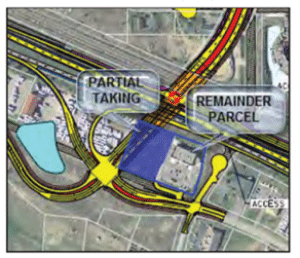BY BENJAMIN TOZER
Eminent domain is an “awesome” power: the ability of the state, or its delegates, to take an individual’s property without that individual’s consent.1 Under the United States and Minnesota Constitutions, that “awesome” power comes with a corresponding responsibility: to pay “just compensation” to the owner of the property.2 In cases where not all of an owner’s property is acquired, just compensation includes compensation not just for the property taken, but also lost value to the owner’s remaining land—an element of damages known as severance damages.3 To this end, Minnesota follows the “before” and “after” rule, comparing the value of the property before the taking with the value after the taking in order to determine the property compensation.4
Often, a property owner or investor will hold contiguous properties in different single-purpose entities. There are potential tax advantages and development advantages to holding property in smaller or separate economic units. The owner can decide to develop the properties together or to sell off one of the economic units. The owner may also decide to develop the property in phases, based on market conditions and forces. An important condemnation issue is whether or not these economic units may be considered as a single property or must be considered as multiple properties. Assume Acme, LLC owns both Green Acres and Blue Acres. A condemning authority takes only a portion of Green Acres, but the project will interfere with the use, access, or some other development potential of Blue Acres as well. Is Acme entitled to damages caused to Blue Acres as well as Green Acres? The answer, as in so many legal issues, is that it depends. Primarily, it depends on whether in the marketplace, Blue Acres and Green Acres are considered part of the same larger parcel.
The “larger parcel” rule considers three factors: unity of ownership, unity of use, and physical unity, also known as contiguity.5 The use considered is one of highest and best use.6 For properties that are not contiguous, Minnesota law provides a specific rule in Minn. Stat. §117.086, subd. 1. A recent unpublished Minnesota Court of Appeals case helps spell out the rule in Minnesota for contiguous properties.
In December 2017, the court of appeals ruled, in County of Anoka v. Ramsey-Arbor Properties, LLC,7 on an issue related to the so-called “larger parcel” test. Anoka County acquired a portion of land known in the court proceedings as Parcel 20. The landowner owned Parcel 20 along with a contiguous tract adjoining the eastern boundary of Parcel 20, known in the proceedings as Tract A.

The landowner purchased Parcel 20 and Tract A together and had planned a single, phased development involving the property. At the time of the taking, Tract A was improved with a commercial structure leased to a bank and Parcel 20 was mostly unimproved, though the two shared parking, sanitary sewer, storm sewer, lighting, fire protection, zoning, and guidance.
At the district court level, the county moved for partial summary judgment to exclude a claim for any damages to Tract A, arguing that because the parcels were separate tax parcels and because Tract A was improved while Parcel 20 was not, that the larger parcel test was not met in the case and that damages to Tract A could not be found. The district court granted the county’s motion.
The landowner appealed to the court of appeals, which overturned the district court opinion. The court of appeals held that the required question was whether the “physically distinct tracts [were] adaptable to, and actually and permanently used as, a single unitary tract” and that that question was a question for the jury unless the evidence was conclusive.8
In this case, the court overturned the district court because the evidence was not conclusive and genuine issues of material fact existed as to whether property was a single unitary tract. Disputes identified by the court of appeals included facts related to the shared driveway, lighting, utilities, and storm water systems; differing appraisers’ opinions; and the intent of the owner with respect to the development, irrigation, landscaping, and zoning, among other issues.
In condemnation cases where the issue involves contiguous land, if there are disputed
facts then the question of what land must be considered and compensated for will be a decision for the jury. It is vital in such cases that condemnation counsel closely follows the disputed facts and issues that may demonstrate a sufficient connection to claim damages.
BENJAMIN TOZER practices in the areas of litigation and real estate work, with particular expertise related to litigation and advice on issues pertaining to condemnation and regulatory processes. Ben is focused on assisting landowners and taking authorities in condemnation. He has substantial experience in eminent domain work.
Notes
1 Moorhead Econ. Dev. Auth. v. Anda, 789 N.W.2d 860, 875 (Minn. 2010).
2 U.S. Const. Amend. V; Minn. Const. art. I, § 13.
3 Victor Co. v. State, 290 Minn. 40, 44, 186 N.W.2d 168, 171–72 (1971).
4 State v. Strom, 493 N.W.2d 554, 558–59 (Minn. 1992).
5 J.D. Eaton, Real Estate Valuation in Litigation, 76 (2nd ed., Appraisal Institute 1995).
6 See Id.; Minneapolis – St. Paul Sanitary Dist. v. Fitzpatrick, 201 Minn. 442, 277 N.W.2d 394, 399 (1937).
7 County of Anoka v. Ramsey-Arbor Properties, LLC, No. A17-1060, 2017 WL 6567697 (Minn. Ct. App. 12/26/2017) (unpublished).
8 Id. at 2 (citing Victor Co. v. State, 290 Minn. 40, 41, 186 N.W.2d 168, 170–72 (1971)).